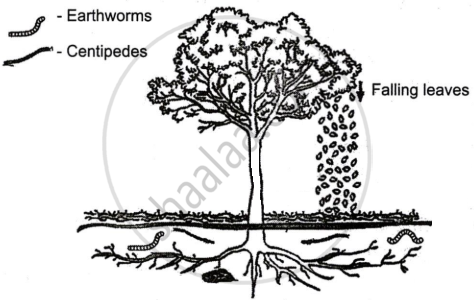Advertisements
Advertisements
प्रश्न
The diagram given below shows the process of decomposition in the forest ecosystem.
Observe the diagram carefully and answer the questions that follow.

- Why is the breaking down of complex organic matter an important event in the ecosystem?
- The forest soil has a higher humus content than the desert soil. Give a reason to justify this statement.
- Earthworms and centipedes play an important role in the decomposition process of forest ecosystems. At which stage of the decomposition are these organisms involved?
-
The net annual primary productivity of a particular wetland ecosystem is found to be 8,000 kcal/m2 per year. If respiration by the aquatic producers is 11,000 kcal/m2 per year, calculate the gross primary productivity for this ecosystem.
संक्षेप में उत्तर
उत्तर
- Decomposition is the process of converting complex organic compounds into simpler ones. It is a crucial aspect of Earth's life cycle, supplying nutrients to plants and new species. Plants' important nutrients are mineralized, which is the process of converting organic nutrients into soluble forms that are readily available to plants. Higher rates of decomposition result in faster cycling of important plant nutrients, which influences productivity.
- Forests have more trees and animals, which add to the soil's organic material. Humus is a black organic material that forms in soil as plant and animal waste decays. Forest soil contains more humus than arid soil.
- Stage 3, often known as active decay, is when earthworms and centipedes begin to function. Earthworms eat soil and decaying plant matter, such as straw, leaf litter and dead roots. They combine dead surface litter with soil, allowing microorganisms to decompose it more easily.
-
NPP = GPP − R
Given:
NPP = 8000 kcal/m2/year and R = 11000 kcal/m2/year
So, 8000 = GPP − 11000
GPP = 8000 + 11000
GPP = 19000 kcal/m2/year
Gross primary productivity for this ecosystem is 19000 kcal/m2/year.
shaalaa.com
क्या इस प्रश्न या उत्तर में कोई त्रुटि है?
